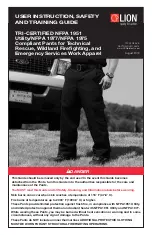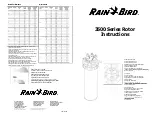
8
4.
PURPOSE AND LIMITATIONS
This Pants is designed to provide LIMITED protection under the requirements of the NFPA
1951 Utility and NFPA 1977 Standards to the legs against hazards TO EMERGENCY
RESPONDERS INVOLVED IN SEARCH, RESCUE, EXTRICATION, SITE STABILIZATION,
AND OTHER MITIGATION OPERATIONS AT OR INVOLVING TECHNICAL RESCUE
AND/OR WILDLAND FIREFIGHTING:
• Flash fire,
• Physical hazards, including cuts and abrasion.
Do not use for
ANY structural
or proximity
firefighting.
Do not use for
direct contact
with flames or
molten metal.
Do not use
for protection
against
hazardous
radiological
agents.
Do not use
for protection
against
hazardous
biological
agents.
Do not use
for protection
against
hazardous
chemical
agents.
Burns are a function of time and temperature. The higher the temperature of the heat source and the
longer the exposure time, the greater the severity of burns.
FIRST DEGREE BURNS begin when skin temperature reaches
118° F (47.8° C)
.
SECOND DEGREE BURNS occur when skin temperature reaches approx.
131° F (55° C)
.
THIRD DEGREE BURNS occur when skin temperature reaches approx.
152° F (66.7° C)
.
!
WARNING
DO NOT use your Pants for the following:
•
Structural, Proximity and Entry Firefighting (see Definitions)
•
Activities requiring direct contact with flames or molten metal
•
Protection against all hazardous materials, and all biological or radiological agents.
!
DANGER
Technical Rescue and/or Wildland Firefighter personnel who are exposed to a flashover, backdraft, or
other flame and high heat environments are at
EXTREME
risk for extensive burn injuries and death
while wearing their NFPA 1951 Utility/NFPA 1977/NFPA 1975 Tri-Certified Technical Rescue/Wildland
Firefighting Pants!
!
DANGER
Risk Assessment
The authority having jurisdiction (see Definitions) should perform a risk
assessment to identify the hazards present and to determine the suitability
of the NFPA 1951 Utility/NFPA 1977/NFPA 1975 Tri-Certified Pants. For
each of the activities described as Technical Rescue/Wildland Firefighting
rescue incidents, the authority having jurisdiction should determine if
protection provided by your Pants is commensurate with the level of
protection needed as deemed by the hazards present. For example, in an
automobile extrication the decision for using Technical Rescue /Wildland
protective ensembles versus structural firefighting protective ensembles
can be dependent on the level of fire risk at the incident.
Controlled lab tests in the NFPA 1951 Utility and NFPA 1977 Standards “should not be deemed as
defining or establishing performance levels for protection from all environments”. You should always use
extreme caution in any Technical Rescue and/or Wildland Firefighting to avoid the risk of injuries. See
NFPA 1951 Utility, Para.1.2.3 and NFPA 1977, Para.1.2.3.
!
WARNING
You may have
very little or no warning time
from feeling heat or pain before skin begins to
burn at 118 degrees F. You need to be constantly aware of the buildup of heat in the surrounding
environment and in your Pants and be ready to escape to a cool area where you can remove hot
Pants quickly to help prevent or reduce the severity of burns.
!
WARNING
Protective properties in a new NFPA 1951 Utility/NFPA 1977/NFPA 1975 Tri-Certified Pants will
diminish as the product is worn and ages. To reduce the risk of injuries, you MUST follow the
recommendations in this Guide for inspection and retirement of your Pants to ensure that the
Pants is not used past its Useful Life. NFPA 1951 Utility, and NFPA 1977.
!
WARNING
NFPA 1951 Utility/NFPA 1977/NFPA 1975 Tri-Certified Pants should NEVER be used alone by
responders in auto extrication incidents where there is ANY risk of fire.
!
WARNING
Содержание NFPA 1975
Страница 22: ...22 NOTES...









































